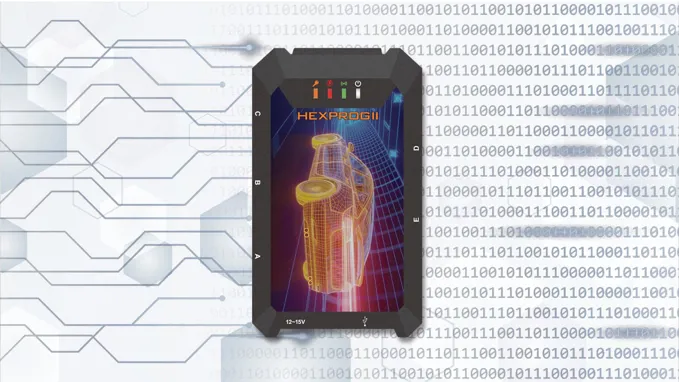Overview of Hexprog II
What is Hexprog II?
Hexprog II is an advanced and comprehensive ECU Programming and Chip Tuning Tool designed to meet the needs of automotive professionals across various sectors of the industry. Its primary functions—reading, writing, and cloning ECU data—make it a vital resource for technicians working with a wide range of vehicle models, from everyday consumer cars to high-performance luxury vehicles.
One of the standout features of Hexprog II is its user-friendly interface. The ECU Programming Software is designed with the technician in mind, allowing both seasoned professionals and newcomers to navigate its functions with ease. The intuitive layout simplifies complex tasks, reducing the learning curve and enabling users to quickly adapt to the tool. This accessibility is crucial in fast-paced environments where time is of the essence, ensuring that technicians can focus on delivering quality service rather than struggling with complicated software.
In terms of functionality, Hexprog II is equipped with advanced capabilities that set it apart from other tools on the market. Its robust ECU Programming features allow users to modify ECU settings, optimize performance, and implement custom tuning solutions tailored to specific vehicle requirements. This flexibility is particularly beneficial for performance tuners who aim to enhance engine efficiency and power output.
Moreover, Hexprog II boasts exceptional compatibility with various automotive brands, making it a versatile choice for multi-brand workshops. It supports a broad spectrum of ECUs, from standard engine control units to more complex systems such as transmission control modules. This wide-ranging compatibility allows technicians to service a diverse fleet of vehicles without needing multiple tools, thus streamlining operations and improving overall efficiency.
Key Features of Hexprog II
- Wide Compatibility: Hexprog II supports a vast array of vehicles and ECUs, allowing technicians to work on multiple brands with a single ECU Chip Tuning Tool.
- Intuitive User Interface: The ECU Programming Software is designed for ease of use, enabling both experienced technicians and newcomers to navigate its features without extensive training.
- Advanced Data Management: Users can efficiently manage ECU data, including reading, writing, and backing up information.
- Security Features: The Chip Tuning Tool incorporates robust security measures to protect sensitive ECU data during reading and writing processes.
The Read Function of Hexprog II
Purpose of the Read Function
The read function in Hexprog II is designed to extract data from an ECU. This data may include firmware, calibration files, diagnostic trouble codes (DTCs), Individual Serial Number (ISN) for BMW and other essential parameters that define the operation of the ECU.
Why Reading ECU Data is Important
- Data Backup: Reading the ECU data allows technicians to create backups before making any modifications. This ensures that original settings can be restored if needed.
- Diagnostics: By reading data from the ECU, technicians can identify faults or sort out anomalies that may be affecting vehicle performance. This diagnostic capability is crucial for effective troubleshooting.
- Tuning and Performance Enhancements: Reading ECU data enables performance tuners to analyze existing maps and settings, facilitating informed modifications for improved vehicle performance.
The Reading Process with Hexprog II
- Connection: To begin, the technician connects Hexprog II to the vehicle’s OBD-II port or directly to the ECU using the appropriate connectors.
- Initiate Reading: The technician launches Hexprog II ECU Programming Software and selects the reading function. The software communicates with the ECU to establish a connection.
- Data Extraction: Hexprog II retrieves the ECU data, which may include various parameters such as firmware versions, calibration settings, and any stored DTCs.
- Data Verification: After extraction, the software verifies the data to ensure accuracy. This step is essential to confirm that the read process was successful.
- Data Storage: Once verified, the extracted data can be saved in a secure format for future reference or modifications.
Applications of the Read Function
- Maintenance and Repair: Technicians can read ECU data to diagnose issues, facilitating timely repairs and maintenance.
- Performance Tuning: Performance specialists can analyze existing maps and settings, allowing them to create optimized tuning files for enhanced vehicle performance.
- Data Recovery: In cases where an ECU has been corrupted or malfunctioned, reading data can help recover essential parameters, aiding in repairs or replacements.
The Write Function of Hexprog II
Purpose of the Write Function
The write function in Hexprog II is used to upload new data or modified settings back to the ECU. This process is critical for implementing changes based on diagnostics, performance tuning, ECU replacement or Chip Tuning.
Importance of Writing ECU Data
- Programming New ECUs: When replacing a faulty ECU, writing the original data to the new unit ensures that it operates identically to the original.
- Tuning Modifications: After analyzing and modifying ECU data for performance enhancements, the write function allows technicians to upload these changes to the ECU.
- Restoring Original Settings: If modifications lead to issues or undesirable performance, the write function can restore the ECU to its original state using previously saved data.
The Writing Process with Hexprog II
- Connection: As with the reading process, the technician connects Hexprog II to the vehicle’s OBD-II port or directly to the ECU.
- Select Writing Function: Within Hexprog II ECU Programming Software, the technician selects the write function and chooses the specific data file to be uploaded.
- Data Upload: Hexprog II communicates with the ECU and begins the data writing process. This step involves transferring the selected data to the ECU’s memory.
- Verification of Write Operation: After the writing process is complete, the software verifies that the data has been correctly written to the ECU. This verification is crucial to ensure that the ECU operates as intended.
- Functional Testing: Once the data has been successfully written, the technician performs functional tests to confirm that the ECU operates correctly with the new settings.
Applications of the Write Function
- ECU Replacement: Writing original data to a new ECU allows for a seamless transition and consistent vehicle performance.
- Performance Tuning: After modifying ECU maps, the write function enables the implementation of performance enhancements, such as increased horsepower or improved fuel efficiency.
- Restoration of Settings: In cases where modifications do not yield the desired results, the write function can restore original settings, allowing for further adjustments or troubleshooting.
Benefits of Using Hexprog II for Read and Write Functions
Enhanced Efficiency
The read and write functions of Hexprog II streamline the processes of data extraction and programming. This efficiency is particularly valuable in busy repair shops, where time is of the essence.
Improved Accuracy
Hexprog II ensures that data is accurately read and written, minimizing the risk of errors that could lead to performance issues or ECU malfunctions. The verification steps during both processes enhance the reliability of the data.
Versatility
Hexprog II’s compatibility with a wide range of ECUs makes it a versatile tool for automotive technicians. The ability to read and write data across multiple brands and models reduces the need for multiple tools.
Data Management
The software provides advanced data management features, allowing technicians to easily store, organize, and retrieve ECU data. This capability enhances the overall workflow in repair and tuning environments.
Diagnostic Capabilities
With its read function, Hexprog II not only facilitates ECU programming but also serves as a powerful diagnostic tool. Technicians can quickly identify issues based on the data retrieved from the ECU, leading to more effective repairs.
Challenges and Considerations
Security Measures
Modern ECUs often have built-in security protocols that may complicate the reading and writing processes. Technicians need to be familiar with these protocols to avoid triggering security locks or voiding warranties.
Firmware Compatibility
Different ECU models may have varying firmware versions, which can lead to compatibility issues during the writing process. It’s essential for technicians to verify firmware compatibility before attempting to write new data.
Technical Knowledge
While Hexprog II is designed for ease of use, a solid understanding of automotive electronics and ECU functionality is necessary. Technicians should have the requisite training to effectively utilize the tool and interpret the data accurately.
Future Developments in ECU Programming
As automotive technology continues to evolve, tools like Hexprog II are likely to undergo advancements. Potential developments include:
Integration with Advanced Diagnostics
Future versions of Hexprog II could integrate more advanced diagnostic capabilities, allowing for real-time monitoring and analysis of ECU performance alongside reading and writing functions.
Enhanced User Interfaces
Ongoing improvements in user interface design could further streamline the read and write processes, making it even easier for technicians to navigate the software.
Cloud-Based Solutions
Cloud integration may offer enhanced data storage and sharing capabilities, allowing technicians to access ECU data from multiple devices and locations.
Conclusion
The read and write functions of Hexprog II are fundamental to the effective management of ECU data in modern vehicles. By facilitating accurate data extraction and programming, Hexprog II empowers technicians to perform diagnostics, tune performance, and replace faulty units with ease. Its versatility, efficiency, and reliability make it an essential ECU Programming Tool in the automotive industry. As technology advances, the capabilities of Hexprog II are expected to expand, further enhancing its role in ECU Programming and automotive diagnostics.
As technology progresses, the capabilities of Hexprog II are poised to expand significantly, strengthening its role in Chip Tuning, ECU Programming, and automotive diagnostics. This evolution positions Hexprog II as an essential ECU Programming Tool for optimizing vehicle performance and ensuring peak ECU functionality, paving the way for the future of automotive engineering.
With its advanced features, Hexprog II will enhance the precision of Chip Tuning processes and elevate the efficacy of ECU Programming, leading to improved overall vehicle efficiency and reliability. The integration of cutting-edge algorithms and real-time data analysis will empower technicians to make informed decisions, enabling more tailored and effective tuning solutions. The software’s enhanced capabilities for reading and writing ECU data will streamline the Chip Tuning process, allowing for quicker adjustments and refinements.
Anticipated compatibility with emerging automotive technologies, including electric and hybrid systems, will broaden Hexprog II's application across diverse vehicle platforms. Its ability to interface with a wide range of ECUs ensures that even the latest models can benefit from optimal Chip Tuning strategies.
As the automotive landscape continues to evolve, Hexprog II is set to play a pivotal role in driving innovation in ECU Programming and Chip Tuning. By streamlining diagnostics and facilitating seamless communication between vehicles and diagnostic tools, Hexprog II not only supports better performance but also contributes to sustainability efforts by optimizing fuel efficiency and reducing emissions. Ultimately, Hexprog II stands at the forefront of a new era in automotive engineering, where enhanced performance, reliability, and environmental consciousness converge through advanced Chip Tuning and ECU Programming solutions.



